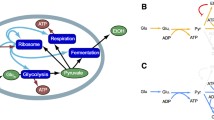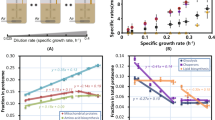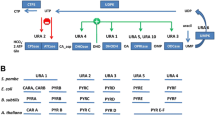Abstract
Prokaryotic organisms preferentially utilize less energetically costly amino acids in highly expressed genes. Studies have shown that the proteome of Saccharomyces cerevisiae also exhibits this behavior, but only in broad terms. This study examines the question of metabolic efficiency as a proteome-shaping force at a finer scale, examining whether trends consistent with cost minimization as an evolutionary force are present independent of protein function and amino acid physicochemical property, and consistently with respect to amino acid biosynthetic costs. Inverse correlations between the average amino acid biosynthetic cost of the protein product and the levels of gene expression in S. cerevisiae are consistent with natural selection to minimize costs. There are, however, patterns of amino acid usage that raise questions about the strength (and possibly the universality) of this selective force in shaping S. cerevisiae’s proteome.


Similar content being viewed by others
References
Akashi H (2003) Translational selection and yeast proteome evolution. Genetics 164(4):1291–1303
Akashi H, Gojobori T (2002) Metabolic efficiency and amino acid composition in the proteomes of Escherichia coli and Bacillus subtilis. Proc Natl Acad Sci USA 99(6):3695–3700
Altschul S, Gish W, Miller W, Myers E, Lipman D (1990) Basic local alignment search tool. J Mol Biol 215:403–410
Black SD, Mould DR (1991) Development of hydrophobicity parameters to analyze proteins which bear post- or cotranslational modifications. Anal Biochem 193(1):72–82
Brocchieri L, Karlin S (2005) Protein length in eukaryotic and prokaryotic proteomes. Nucleic Acids Res 33(10):3390–3400
Craig CL, Weber RS (1998) Selection costs of amino acid substitutions in cole1 and colia gene clusters harbored by Escherichia coli. Int J Biol Macromol 24:109–118
Dickinson J, Schweizer M (1999) The metabolism and molecular physiology of Saccharomyces cerevisiae. Taylor & Francis, London
dos Reis M, Wernisch L, Savva R (2003) Unexpected correlations between gene expression and codon usage bias from microarray data for the whole Escherichia coli K-12 genome. Nucleic Acids Res 31(23):6976–6985
Eyre-Walker A (1996) Synonymous codon bias is related to gene length in Escherichia coli: selection for translational accuracy? Mol Biol Evol 13:864–872
Garcia-Vallvé S, Guzman E, Montero MA, Romeu A (2003) HGT-DB: a database of putative horizontally transferred genes in prokaryotic complete genomes. Nucleic Acids Res 31(1):187–189
Ghaemmaghami S, Huh W-K, Bower K, Howson RW, Belle A, Dephoure N, O’Shea EK, Weissman JS (2003) Global analysis of protein expression in yeast. Nature 425(6959):737–741
Goffeau A, Barrell BG, Bussey H, Davis RW, Dujon B, Feldmann H, Galibert F, Hoheisel JD, Jacq C, Johnston M, Louis EJ, Mewes HW, Murakami Y, Philippsen P, Tettelin H, Oliver SG (1996) Life with 6000 genes. Science 274(5287):546–567
Güldener U, Münsterkötter M, Kastenmüller G, Strack N, van Helden J, Lemer C, Richelles J, Wodak SJ, García-Martínez J, Pérez-Ortín JE, Michael H, Kaps A, Talla E, Dujon B, André B, Souciet JL, De Montigny J, Bon E, Gaillardin C, Mewes HW (2005) CYGD: the Comprehensive Yeast Genome Database. Nucleic Acids Res 33(Database Issue):D364–D368
Gutierrez G, Marquez L, Maryn A (1996) Preference for guanosine at first codon position in highly expressed Escherichia coli genes. A relationship with translational efficiency. Nucleic Acids Res 24:2525–2527
Hall C, Brachat S, Dietrich FS (2005) Contribution of horizontal gene transfer to the evolution of Saccharomyces cerevisiae. Eukaryot Cell 4(6):1102–1115
Heizer EM Jr, Raiford DWIII, Raymer ML, Doom TE, Miller RV, Krane DE (2006) Amino acid cost and codon-usage biases in 6 prokaryotic genomes: a whole-genome analysis. Mol Biol Evol 23(9):1670–1680
Holstege FC, Jennings EG, Wyrick JJ, Lee TI, Hengartner CJ, Green MR, Golub TR, Lander ES, Young RA (1998) Dissecting the regulatory circuitry of a eukaryotic genome. Cell 95(5):717–728
Jain R, Rivera MC, Lake JA (1999) Horizontal gene transfer among genomes: the complexity hypothesis. Proc Natl Acad Sci USA 96(7):3801–3806
Kahali B, Basak S, Ghosh TC (2007) Reinvestigating the codon and amino acid usage of S. cerevisiae genome: a new insight from protein secondary structure analysis. Biochem Biophys Res Commun 354(3):693–699
Mantel N, Haenszel W (1959) Statistical aspects of the analysis of data from retrospective studies of disease. J Natl Cancer Inst 22:719–748
Nei M (1975) Molecular population genetics and evolution. Front Biol 40:I–288
Seligmann H (2003) Cost-minimization of amino acid usage. J Mol Evol 56(2):151–161
Sharp PM, Li WH (1987) The codon adaptation index—a measure of directional synonymous codon usage bias, and its potential applications. Nucleic Acids Res 15:1281–1295
Spearman C (1904) General intelligence objectively determined and measured. Am J Psychol 15:201–293
Swire J (2007) Selection on synthesis cost affects interprotein amino acid usage in all three domains of life. J Mol Evol 64(5):558–571
Urrutia AO, Hurst LD (2003) The signature of selection mediated by expression on human genes. Genome Res 13(10):2260–2264
Wagner A (2005) Energy constraints on the evolution of gene expression. Mol Biol Evol 22(6):1365–1374
Warringer J, Blomberg A (2006) Evolutionary constraints on yeast protein size. BMC Evol Biol 6:61
Zubay G (1998) Biochemistry. William C, Brown, New York
Acknowledgments
This study was supported in part by Grant MBC-0132097 to R.V.M. and by NSF Grant DEB-0521964 to H.A. We also thank an anonymous reviewer for numerous helpful comments and suggestions regarding an early version of the manuscript.
Author information
Authors and Affiliations
Corresponding author
Rights and permissions
About this article
Cite this article
Raiford, D.W., Heizer, E.M., Miller, R.V. et al. Do Amino Acid Biosynthetic Costs Constrain Protein Evolution in Saccharomyces cerevisiae?. J Mol Evol 67, 621–630 (2008). https://doi.org/10.1007/s00239-008-9162-9
Received:
Revised:
Accepted:
Published:
Issue Date:
DOI: https://doi.org/10.1007/s00239-008-9162-9




